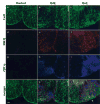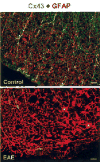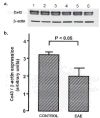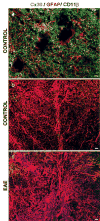Connexin43, the major gap junction protein of astrocytes, is down-regulated in inflamed white matter in an animal model of multiple sclerosis
- PMID: 15898103
- PMCID: PMC1226319
- DOI: 10.1002/jnr.20474
Connexin43, the major gap junction protein of astrocytes, is down-regulated in inflamed white matter in an animal model of multiple sclerosis
Abstract
Both multiple sclerosis (MS) and experimental autoimmune encephalomyelitis (EAE), its animal model, involve inflammatory attack on central nervous system (CNS) white matter, leading to demyelination and axonal damage. Changes in astrocytic morphology and function are also prominent features of MS and EAE. Resting astrocytes form a network that is interconnected through gap junctions, composed mainly of connexin43 (Cx43) protein. Although astrocytic gap junctional connectivity is known to be altered in many CNS pathologies, little is known about Cx43 expression in inflammatory demyelinating disease. Therefore, we evaluated the expression of Cx43 in spinal cords of EAE mice compared with healthy controls. Lumbar ventral white matter areas were heavily infiltrated with CD11beta-immunoreactive monocytes, and within these infiltrated regions loss of Cx43 immunoreactivity was evident. These regions also showed axonal dystrophy, demonstrated by the abnormally dephosphorylated heavy-chain neurofilament proteins. Astrocytes in these Cx43-depleted lesions were strongly glial fibrillary acidic protein reactive. Significant loss (38%) of Cx43 protein in EAE mouse at the lumbar portion of spinal cords was confirmed by Western blot analysis. Decreased Cx43 transcript level was also observed on cDNA microarray analysis. In addition to changes in Cx43 expression, numerous other genes were altered, including those encoding adhesion and extracellular matrix proteins. Our data support the notion that, in addition to damage of myelinating glia, altered astrocyte connectivity is a prominent feature of inflammatory demyelination.
Copyright 2005 Wiley-Liss, Inc.
Figures






Similar articles
-
Connexin 30 Deficiency Attenuates Chronic but Not Acute Phases of Experimental Autoimmune Encephalomyelitis Through Induction of Neuroprotective Microglia.Front Immunol. 2018 Nov 7;9:2588. doi: 10.3389/fimmu.2018.02588. eCollection 2018. Front Immunol. 2018. PMID: 30464764 Free PMC article.
-
Transcript analysis of laser capture microdissected white matter astrocytes and higher phenol sulfotransferase 1A1 expression during autoimmune neuroinflammation.J Neuroinflammation. 2015 Jul 4;12:130. doi: 10.1186/s12974-015-0348-y. J Neuroinflammation. 2015. PMID: 26141738 Free PMC article.
-
Connexin43 and astrocytic gap junctions in the rat spinal cord after acute compression injury.J Comp Neurol. 1997 Jun 2;382(2):199-214. J Comp Neurol. 1997. PMID: 9183689
-
Early disruption of glial communication via connexin gap junction in multiple sclerosis, Baló's disease and neuromyelitis optica.Neuropathology. 2015 Oct;35(5):469-80. doi: 10.1111/neup.12211. Epub 2015 May 28. Neuropathology. 2015. PMID: 26016402 Review.
-
Connexin 43/47 channels are important for astrocyte/ oligodendrocyte cross-talk in myelination and demyelination.J Biosci. 2018 Dec;43(5):1055-1068. doi: 10.1007/s12038-018-9811-0. J Biosci. 2018. PMID: 30541963 Free PMC article. Review.
Cited by
-
Hippocampus-based contextual memory alters the morphological characteristics of astrocytes in the dentate gyrus.Mol Brain. 2016 Jul 26;9(1):72. doi: 10.1186/s13041-016-0253-z. Mol Brain. 2016. PMID: 27460927 Free PMC article.
-
Organizational principles of the connexin-related brain transcriptome.J Membr Biol. 2007 Aug;218(1-3):39-47. doi: 10.1007/s00232-007-9049-5. Epub 2007 Jul 27. J Membr Biol. 2007. PMID: 17657523
-
Connexin 43 astrocytopathy linked to rapidly progressive multiple sclerosis and neuromyelitis optica.PLoS One. 2013 Aug 22;8(8):e72919. doi: 10.1371/journal.pone.0072919. eCollection 2013. PLoS One. 2013. PMID: 23991165 Free PMC article.
-
Similar transcriptomic alterations in Cx43 knockdown and knockout astrocytes.Cell Commun Adhes. 2008 May;15(1):195-206. doi: 10.1080/15419060802014222. Cell Commun Adhes. 2008. PMID: 18649190 Free PMC article.
-
Integrating the Ribonucleic Acid Sequencing Data From Various Studies for Exploring the Multiple Sclerosis-Related Long Noncoding Ribonucleic Acids and Their Functions.Front Genet. 2019 Nov 12;10:1136. doi: 10.3389/fgene.2019.01136. eCollection 2019. Front Genet. 2019. PMID: 31781177 Free PMC article.
References
-
- Adams RD, Kubik CS. The morbid anatomy of the demyelinative disease. Am J Med. 1952;12:510–546. - PubMed
-
- Alexander DB, Goldberg GS. Transfer of biologically important molecules between cells through gap junction channels. Curr Med Chem. 2003;10:2045–2058. - PubMed
-
- Bauer J, Berkenbosch F, Van Dam AM, Dijkstra CD. Demonstration of interleukin-1 beta in Lewis rat brain during experimental allergic encephalomyelitis by immunocytochemistry at the light and ultra-structural level. J Neuroimmunol. 1993;48:13–21. - PubMed
-
- Bauer J, Huitinga I, Zhao W, Lassmann H, Hickey WF, Dijkestra CD. The role of macrophages, perivascular cells, and microglial cells in the pathogenesis of experimental autoimmune encephalomyelitis. Glia. 1995;15:437–446. - PubMed
-
- Benn T, Halfpenny C, Scolding N. Glial cells as targets for cytotoxic immune mediators. Glia. 2001;36:200–211. - PubMed
Publication types
MeSH terms
Substances
Grants and funding
LinkOut - more resources
Full Text Sources
Other Literature Sources
Molecular Biology Databases
Miscellaneous

